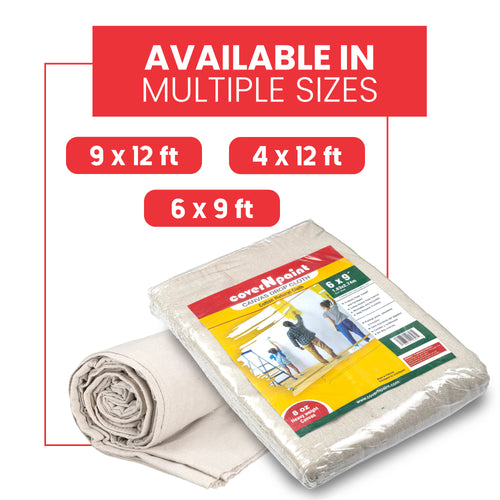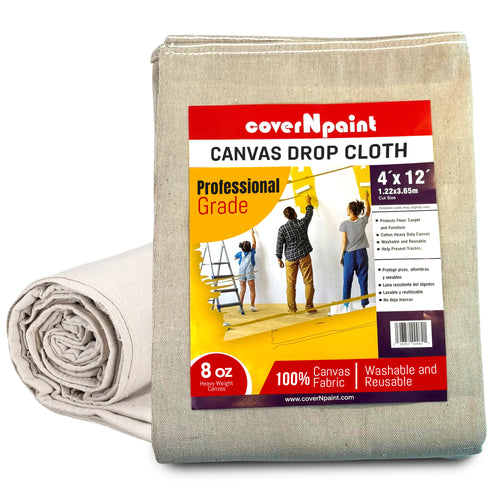When tackling a painting project, a major concern for both DIY enthusiasts and professional painters is safeguarding the surrounding area from unintended spills and splashes. Floors and furniture are especially susceptible to paint stains, which can be tough to clean and often demand considerable effort to fix. Painters tarps are a crucial tool in preventing such messes and ensuring a cleaner, more efficient painting process.
Understanding Drop Cloths
Drop cloths are protective sheets used during painting projects to shield surfaces from paint spills, splashes, and drips. They come in various materials, sizes, and types, each offering different levels of protection and ease of use.

Materials Commonly Used for Drop Cloths:
Canvas:
Canvas drop cloths are favored for their durability and absorbent qualities, making them a go-to choice for managing large spills. Their robust fabric not only withstands heavy use but also absorbs excess paint efficiently, reducing the risk of mess and splatter. This absorbency helps keep surfaces clean and allows for easy cleanup, enhancing their appeal for both DIY projects and professional use.
Plastic:
Lightweight and waterproof, plastic drop cloths are often used for protecting surfaces from paint and other liquids. However, they can be prone to tearing and may not be as effective at preventing paint from seeping through if they are not thick enough.
Paper:
Often used for covering floors, paper drop cloths are disposable and can be a good choice for smaller projects. They are generally less durable and may not provide as much protection as canvas or plastic options.
Polyethylene:
This type of plastic is thicker and more durable than standard plastic drop cloths, offering better protection against spills and splashes.
Effectiveness of Drop Cloths
The effectiveness of a drop cloth in protecting floors and furniture largely depends on its material and thickness. Let’s examine the key factors that contribute to their protective qualities:
Absorbency:
Canvas drop cloths are excellent for managing paint spills thanks to their absorbent fibers. They efficiently soak up excess paint, preventing it from spreading and reducing mess. This absorbency simplifies cleanup and provides superior protection for surfaces, making canvas drop cloths a reliable choice for both amateur and professional painters. Their durability and effectiveness in handling spills ensure a cleaner and more controlled painting experience.
Waterproofing:
Plastic and polyethylene drop cloths are renowned for their superior waterproofing, effectively shielding surfaces from paint spills and stains. Their impermeable nature ensures that no paint seeps through, protecting floors and furniture. However, if these drop cloths are not properly secured, they may shift during use, potentially exposing parts of the surface to paint, which could lead to unintended messes.
Durability:
Canvas drop cloths offer superior durability compared to plastic or paper alternatives. They can handle heavy foot traffic and the shifting of furniture without tearing, making them a reliable choice for various projects. In contrast, plastic drop cloths, though functional, are more prone to damage and often need extra care to prevent tears. This resilience makes canvas a preferred option for both homeowners and professionals seeking a long-lasting protective covering.
Ease of Use:
Canvas drop cloths offer durability and a snug fit, though their weight can make them challenging to position. On the other hand, plastic and paper drop cloths are lighter and simpler to handle, but they often require taping to stay in place effectively. While canvas provides stability and longevity, the ease of use with plastic and paper comes with the trade-off of potentially less secure coverage.
Best Practices for Using Drop Cloths
To maximize the effectiveness of drop cloths and ensure thorough protection, follow these best practices:
Proper Placement:
Ensure that drop cloths are laid out completely over the area you wish to protect. For floors, cover the entire surface and secure the edges with painter’s tape to prevent shifting. For furniture, drape the drop cloths over and under items, tucking them in to avoid paint from seeping through.
Secure the Drop Cloth:
To keep drop cloths firmly in place, use painter’s tape or masking tape along the edges and seams. This simple step prevents the cloths from shifting and exposing the surfaces underneath, ensuring a clean and efficient painting or renovation job. Properly secured drop cloths protect your floors and furniture, minimizing cleanup and potential damage.
Overlap Sections:
When using multiple drop cloths, overlap them by several inches to prevent paint from seeping through gaps. Secure the overlapping sections with tape to keep the cloths firmly in place. This simple step ensures complete coverage and protects your surfaces from accidental spills and splashes.
Regular Checks:
During painting, it’s essential to check drop cloths regularly to ensure they stay in place and aren’t becoming overly saturated. If you notice any shifts or excessive wetness, reposition or replace them promptly. This maintenance helps ensure optimal protection for your surfaces and keeps your painting job tidy and efficient.
Clean-Up:
After completing your painting project, carefully remove the drop cloths and check the surfaces underneath. If any paint has seeped through, address it immediately. For water-based paints, a damp cloth should suffice for cleaning, while oil-based paints may require a solvent like turpentine. Prompt action will help prevent any potential damage and keep your surfaces looking their best.
Ending point
Drop cloths play a crucial role in protecting floors and furniture from paint spills and splashes. By understanding the different materials and their protective qualities, you can choose the right type of drop cloth for your project. Whether you opt for canvas, plastic, or paper, following best practices for placement and securing will help ensure that your surfaces remain protected throughout the painting process.












